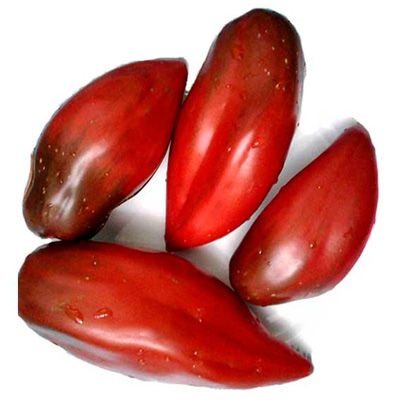
- Category: grade
- Growth type: indeterminate
- Appointment: fresh consumption
- Ripening period: mid-season
- Growing conditions: for closed ground
- Bush size: tall
- Bush height, cm: more than 200
- Ripe fruit color: maroon
- Fruit shape: pepper
- Fruit weight, g: 200-300
Cuban pepper tomatoes can be grown indoors. It should be borne in mind that this tomato is sensitive even to the slightest frost and die already at 0 ° C. The optimum growth temperature is 18-25 ° C. At too high temperatures, it does not emit a red dye - lycopene.
Description of the variety
Indeterminate variety with constant growth throughout the growing season. The fruits are used only fresh.
Cuban pepper is suitable for indoor cultivation. Bushes are tall, grow more than 2 meters.
The main qualities of the fruit
When ripe, the fruits of this variety are of a dark burgundy hue. They are quite large, weighing up to 300 grams. Fleshy flesh is hidden inside. The skin is quite firm.
Taste characteristics
The Cuban pepper fruit tastes sweet.
Ripening and fruiting
The variety is mid-season.
Yield
Cuban pepper is a fruitful variety.
The timing of planting seedlings and planting in the ground
From January to April, seeds are sown for seedlings.

Growing tomato seedlings is an extremely important process, because it largely depends on whether the gardener will be able to harvest at all. All aspects must be taken into account, from seedbed preparation to planting in the ground.
Landing scheme
The planting scheme is standard for most varieties - 40 * 60 cm.

Growing and care
The variety requires pinching and shaping.
Tomato grows best in soils that are drained, warm and well-flavored with humus. Sufficiently nutrient-rich and light soil is the key to success and a bountiful harvest.
The soil for growing tomatoes must be dug deep and enriched with manure or compost.
If organic fertilizers (for example, manure or compost) were not used before planting tomatoes, then it is worth taking ready-made organic mixtures, which, in addition to the necessary nutrients, have a beneficial effect on the soil structure and humus content.
Using nettle compost is also a good solution. Fertilizers should also be used to avoid symptoms of nutrient deficiencies. They begin to be used 3 weeks after planting the seedlings and repeat the procedure every 10-14 days.
Watering tomatoes is an important part of growing tomatoes. An insufficient amount of water will lead to the fact that the fruits are small and tasteless. The amount of watering depends on what stage of growth the plant is in. Before fruit appears, Cuban Pepper should be watered 2-3 times a week, but very generously.
Frequent and small doses of water only moisten the top layer of the soil, which leads to the fact that the roots will grow to the sides and come out of the soil.
With the appearance of fruits, it is necessary to increase the frequency of watering, but the dose of water should be limited. This method of irrigation will allow you to achieve juicy tomatoes.
Humidification of leaves, shoots or fruits is unacceptable and often leads to the development of fungal diseases.
Mulching favorably affects the growth and development of tomatoes. Thanks to the procedure, weed growth and excessive evaporation of water from the soil can be prevented. Moreover, mulch protects plant roots from temperature changes. In addition to black spunbond, it is worth using materials of natural origin, for example, straw, wood chips or sawdust.
Tomato garter Cuban peppercorn requires reliable support. For this purpose, wooden stakes are most often used. Can also be tied to twine or wire, which should extend along the rows. Tying should be done every week during plant growth.
Pruning the lower leaves and stepchildren is also required. The procedure is especially important when spots appear on the shoots, which may be the beginning of an infection. By pruning tomatoes, you will get more light, which is necessary for aroma and taste.




A plant needs different micronutrients at each stage of growth. All fertilizers can be divided into two groups: mineral and organic. Folk remedies are often used: iodine, yeast, bird droppings, eggshells.
It is important to observe the rate and period of feeding. This also applies to folk remedies and organic fertilizers.
Disease and pest resistance
Pest control is essential. Fungicides are used for diseases, and insecticides are used for insects. From folk remedies, neem oil and garlic infusion are popular.


Resistant to adverse weather conditions
Fruits are resistant to cracking. Plants are drought-resistant.

























































































